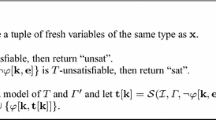Abstract
First-order logic provides a convenient formalism for describing a wide variety of verification conditions. Two main approaches to checking such conditions are pure first-order automated theorem proving (ATP) and automated theorem proving based on satisfiability modulo theories (SMT). Traditional ATP systems are designed to handle quantifiers easily, but often have difficulty reasoning with respect to theories. SMT systems, on the other hand, have built-in support for many useful theories, but have a much more difficult time with quantifiers. One clue on how to get the best of both worlds can be found in the legacy system Simplify which combines built-in theory reasoning with quantifier instantiation heuristics. Inspired by Simplify and motivated by a desire to provide a competitive alternative to ATP systems, this paper describes a methodology for reasoning about quantifiers in SMT systems. We present the methodology in the context of the Abstract DPLL Modulo Theories framework. Besides adapting many of Simplify’s techniques, we also introduce a number of new heuristics. Most important is the notion of instantiation level which provides an effective mechanism for prioritizing and managing the large search space inherent in quantifier instantiation techniques. These techniques have been implemented in the SMT system CVC3. Experimental results show that our methodology enables CVC3 to solve a significant number of quantified benchmarks that were not solvable with previous approaches.
Similar content being viewed by others
References
Baader, F., Snyder, W.: Unification theory. In: Robinson, A., Voronkov, A. (eds.) Handbook of Automated Reasoning, vol. I, chapter 8, pp. 445–532. Elsevier Science, Amsterdam (2001)
Barrett, C., Nieuwenhuis, R., Oliveras, A., Tinelli, C.: Splitting on demand in SAT modulo theories. Technical report 06-05, Department of Computer Science, The University of Iowa (2006)
Barrett, C., Ranise, S., Stump, A., Tinelli, C.: The Satisfiability Modulo Theories Library (SMT-LIB). www.SMT-LIB.org (2008)
Barrett, C., Tinelli, C.: CVC3. In: Damm, W., Hermanns, H. (eds.) Proceedings of the 19th International Conference on Computer Aided Verification (CAV’07), Berlin, Germany. Lecture Notes in Computer Science, vol. 4590, pp. 298–302. Springer, New York (2007)
Barrett, C.W.: Checking validity of quantifier-free formulas in combinations of first-order theories. Ph.D. thesis, Stanford University (2003)
Barrett, C.W., Dill, D.L., Stump, A.: A generalization of Shostak’s method for combining decision procedures. In: Armando, A. (ed.) Proc. FroCoS ’02. LNAI, vol. 2309, pp. 132–146. Springer, New York (2002)
Baumgartner, P., Tinelli, C.: The model evolution calculus as a first-order DPLL method. Artif. Intell. 172, 591–632 (2008)
de Moura, L.M., Bjørner, N.: Efficient E-matching for SMT solvers. In: Pfenning, F. (ed.) CADE. Lecture Notes in Computer Science, vol. 4603, pp. 183–198. Springer, New York (2007)
Denney, E., Fischer, B., Schumann, J.: Using automated theorem provers to certify auto-generated aerospace software. In: Basin, D.A., Rusinowitch, M. (eds.) IJCAR. LNCS, vol. 3097, pp. 198–212. Springer, New York (2004)
Detlefs, D., Nelson, G., Saxe, J.B.: Simplify: a theorem prover for program checking. J. ACM 52(3), 365–473 (2005)
Flanagan, C., Joshi, R., Saxe, J.B.: An explicating theorem prover for quantified formulas. Technical report HPL-2004-199, HP Intelligent Enterprise Technologies Laboratory (2004)
Flanagan, C., Leino, K.R.M., Lillibridge, M., Nelson, G., Saxe, J.B.: Extended static checking for Java. In: Proc. ACM Conference on Programming Language Design and Implementation, pp. 234–245 (2002)
Ganzinger, H., Hagen, G., Nieuwenhuis, R., Oliveras, A., Tinelli, C.: DPLL(T): fast decision procedures. In: Alur, R., Peled, D. (eds.) Proceedings of the 16th International Conference on Computer Aided Verification, CAV’04 (Boston, Massachusetts). LNCS, vol. 3114, pp. 175–188. Springer, New York (2004)
Hooker, J., Rago, G., Chandru, V., Shrivastava, A.: Partial instantiation methods for inference in first order logic. J. Autom. Reason. 28(4), 371–396 (2002)
Moskal, M., Lopuszanski, J., Kiniry, J.: E-matching for fun and profit. In: Krstic, S., Oliveras, A. (eds.) Proceedings of the 5th International Workshop on Satisfiability Modulo Theories (SMT ’07), pp. 25–35. Berlin, Germany (2007)
Nieuwenhuis, R., Oliveras, A., Tinelli, C.: Solving SAT and SAT modulo theories: from an abstract Davis-Putnam-Logemann-Loveland procedure to DPLL(T). J. ACM 53(6), 937–977 (2006)
Plaisted, D.A., Zhu, Y.: Ordered semantic hyper linking. J. Autom. Reason. 25(3), 167–217 (2000)
Prevosto, V., Waldmann, U.: SPASS+T. In: Sutcliffe, G., Schmidt, R., Schulz, S. (eds.) Proceedings of ESCoR: Empirically Successful Computerized Reasoning, Seattle, WA. CEUR Workshop Proceedings, vol. 192, pp. 18–33 (2006)
Riazanov, A., Voronkov, A.: The design and implementation of VAMPIRE. AI Commun. 15(2–3), 91–110 (2002)
Stickel, M.E.: Automated deduction by theory resolution. J. Autom. Reason. 1(4), 333–355 (1985)
Sutcliffe, G.: The IJCAR-2004 automated theorem proving competition. AI Commun. 18(1), 33–40 (2005)
Sutcliffe, G., Suttner, C.: The TPTP problem library: CNF release v1.2.1. J. Autom. Reason. 21(2), 177–203 (1998)
Weidenbach, C., Brahm, U., Hillenbrand, T., Keen, E., Theobald, C., Topic, D.: SPASS version 2.0. In: Voronkov, A. (ed.) CADE. LNCS, vol. 2392, pp. 275–279. Springer, New York (2002)
Author information
Authors and Affiliations
Corresponding author
Additional information
This work was partially supported by a donation from Intel Corp. and by the National Science Foundation under grants 0237422 and 0551645.
Rights and permissions
About this article
Cite this article
Ge, Y., Barrett, C. & Tinelli, C. Solving quantified verification conditions using satisfiability modulo theories. Ann Math Artif Intell 55, 101–122 (2009). https://doi.org/10.1007/s10472-009-9153-6
Published:
Issue Date:
DOI: https://doi.org/10.1007/s10472-009-9153-6
Keywords
- First-order logic
- Quantified verification conditions
- Satisfiability modulo theories
- Quantifier instantiation




